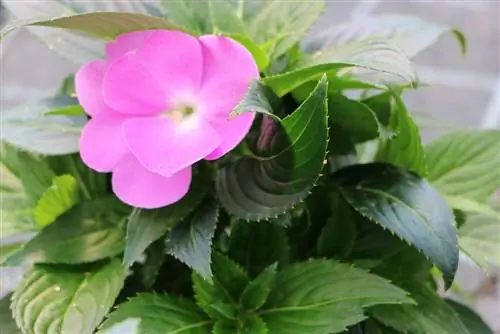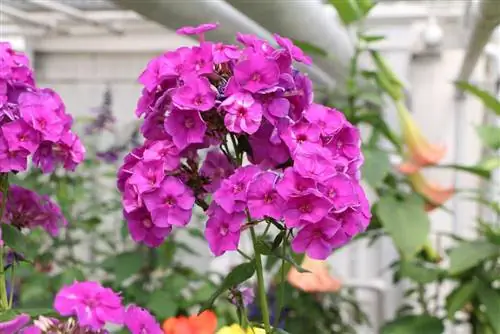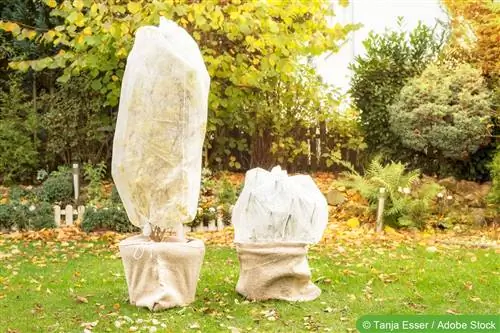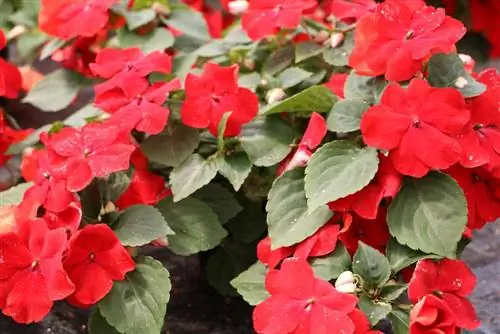- Author admin [email protected].
- Public 2023-12-17 03:39.
- Last modified 2025-06-01 06:48.
With little effort for the gardener, this plant is truly hard-working and the botanical name Impatiens, which also means “the impatient one”, shows the character of the plant, which is impatiently waiting for new flowers from May to October to train. The mostly annual plants belong to the so-called jewelweeds, which grow up to 30 cm high and have a broad habit. The plants are also known as ground cover. Whether in a bowl, pot or box - the hard-working Lieschen is happy with any location.
Appearance of Busy Lieschen
- Overall, the plants grow relatively bushy and are therefore very lush and also perfect as ground cover.
- The flowering period of the Busy Lieschen is from May to October because the plant constantly produces new flowers during this time.
- The plants can grow up to 30 cm high. Because it grows so easily, you should plan enough space when planting out.
Planting busy lizards
As a location, the busy Lieschen appreciates a place that is protected from the wind and partially shaded. However, the plant can also be placed in a sunny location. However, the condition is that the plant does not dry out and is watered regularly. The busy Lieschen doesn't like waterlogging at all, which is why moderate but regular watering is optimal. When choosing a location for the plant, you should keep in mind that the Busy Lieschen can be placed in semi-shady as well as sunny places, but that they cannot tolerate rain at all. Therefore, the location selection should be done carefully and with an anticipation of rain. Temperatures in the range of 18 to 24 °C are perfect for the plant. If the temperatures are above 25 °C, spraying with water is very good for the plant. Provided with a small amount of fertilizer every two weeks, the plant is already completely satisfied and thanks for the undemanding care with abundant flowers.
The needs of the busy Lieschen at a glance:
- a partially shaded or sunny location
- regular, moderate watering
- absolutely no waterlogging
- no rain at all
Wintering of the Busy Lieschen
Generally the plants are annuals. But you can definitely try to take the plant with you into the next year. For this purpose, the plant is brought into the house when the outside temperature is 10 °C and then placed in a sunny location. During the winter the plant is only watered moderately. Fertilization is not necessary during this time. If you're a little lucky, even annual plants can survive the winter without requiring much care. The plants should only be planted again after the Ice Saints in order to protect them from temperatures below 10 °C, even in spring.
The annual plant can be overwintered at:
- Outside temperatures below 10 °C
- moderate watering, without fertilization
Propagation of the Busy Lizzies
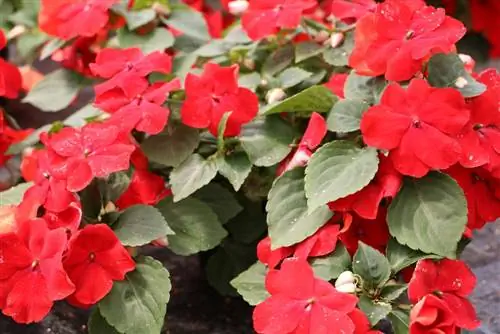
There are two ways to multiply the busy Lieschen. Propagation can occur via seeds or via cuttings. After the plant has flowered, seed capsules form in the places where the flower was. These are initially green, then become glassy light green. Only then are the seeds ripe. However, you can't simply pick off the seed capsules, because then the busy Lizzie lives up to its name as a jewelweed and the seed capsules burst open and scatter the seeds everywhere - just not into the hobby gardener's hand. Harvesting the seeds therefore has to be done in a tricky way. This means that shortly before they are fully ripe, the capsules must be quickly grabbed with a targeted movement and pressed into the hand. Then the seed capsules are twisted off the plant and dried in a warm and dry place in a tall container without a lid. If you are a professional at picking the seed capsules, you can harvest the seeds without any losses. From January onwards, the seeds are simply planted in planters that are not too small and the plants are then released from May after the Ice Saints.
The plant's cuttings can be propagated all year round. Autumn is the best season because the young plants then have the entire winter to thrive in a warm environment. To propagate, the top cuttings are now planted in individual pots and covered with a plastic bag. The cuttings grow in a bright location with regular water supply. After three to four weeks, the cuttings will have developed their roots to such an extent that the plant no longer needs the plastic cover. These plants can also move into the garden after the Ice Saints.
Pests of the Busy Lieschen
The advantage of the plant is that it does not belong to a genus that literally attracts pests. But of course, busy lizards are not completely protected from attacks by pests. Unfavorable conditions for the plant are low humidity or excessive heat. Then the red spiders have the chance to attack the busy Lieschen. It is also important to regularly check the plants for whiteflies and aphids. As a rule, the plants are only moderately affected by the pests. These can then be removed using appropriate means. However, the pests do not endanger the life of the plant and therefore do not pose a serious danger to the busy Lieschen.
Disease infestation reduced to:
- Whiteflies
- Red Spiders
- Aphids
- Spider mites
The cause in each case is that the temperature and/or humidity is too low.
Things worth knowing about the busy Lieschen coming soon
- The busy Lieschen is one of the jewelweeds. The genus includes around 600 species.
- It is an evergreen, perennial, herbaceous plant.
- It originally comes from the East African tropics and Zanzibar.
- The busy Lieschen blooms intensively and for a long time, even without any gardening intervention.
- The plant thrives best in a partially shaded or sunny location with moderate watering without waterlogging.
- In Central Europe, the busy Lieschen is only cultivated as an annual bedding and balcony plant.
- However, they also look good as room decorations in decorative planters.
- Depending on the variety, the plant can grow up to 30 cm high.
- It has soft, fleshy, reddish-striped stems and oval green leaves.
- The plant blooms all summer long with a profusion of small, spurred, five-petalled flowers.
- The flowers can be of very different colors, from white, pink, purple, violet, orange to scarlet and ruby red.
- There are also bicolor and double flowers. Many varieties also have beautifully colored foliage.
- The busy Lieschen is also suitable for hydroponics.
Hard-working lizards have medium nutrient requirements and should be regularly fertilized in low doses. It's best to do this once a week during the flowering period. In order to encourage new blooms, spent flowers must be thinned out from time to time. At temperatures above 25 °C Celsius you should spray the plant with water and ensure higher humidity (tropical plant). Perennial plants are repotted in spring. You can cut back long, bare shoots.
- The plants can be overwintered in a bright place at temperatures around 10 °C.
- There is no fertilization during this time.
- If you want to overwinter a plant, you should not expose it to temperatures below 8 °C.
- Bring the plants into the house in good time in the fall if possible!
Propagation through cuttings works particularly well with double-flowering varieties. Top cuttings can be cut almost all year round and they root relatively easily. However, the best time is in autumn. The young plants are overwintered bright and cool.

